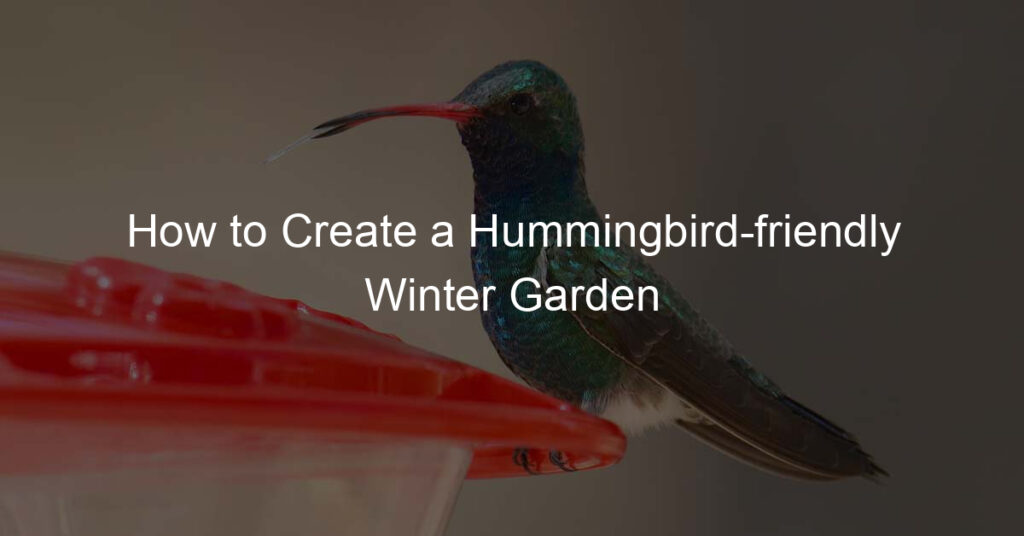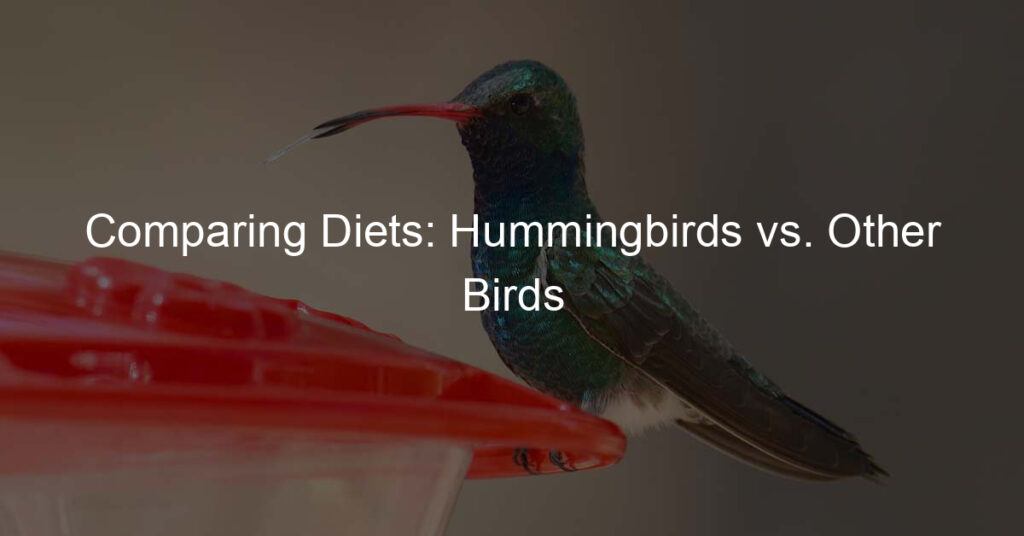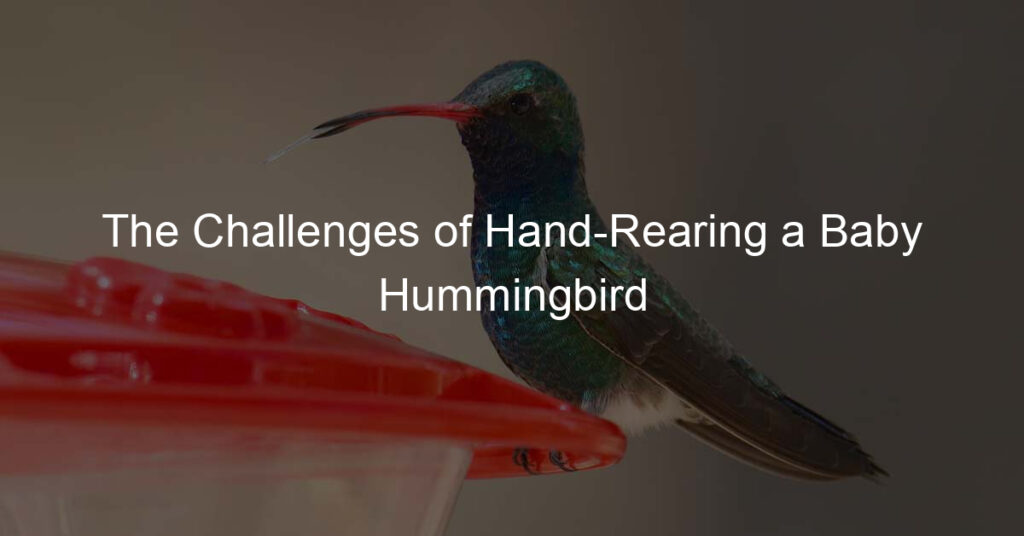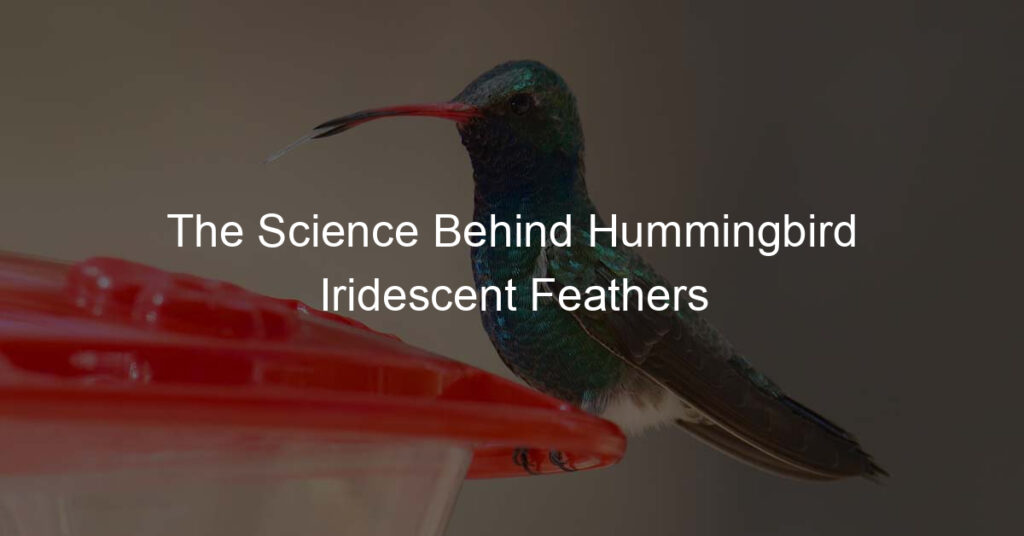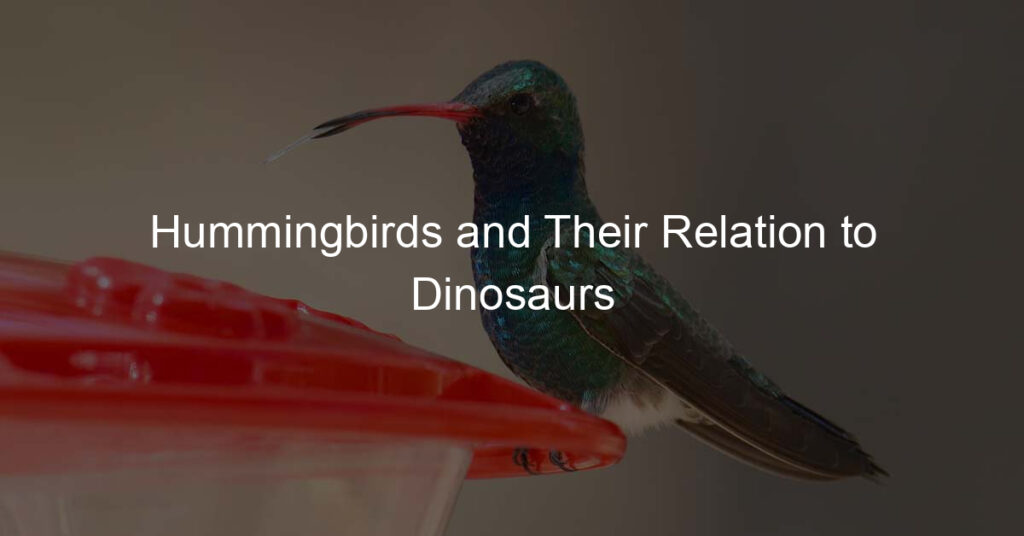In this blog post, we explore the different steps to create a hummingbird-friendly winter garden. From selecting the right plants and feeders to providing adequate shelter and water, each aspect is covered in detail. Whether you're a beginner gardener or an expert, these guidelines will help you attract hummingbirds to your garden, even in the chilly winter months.
Understanding the Winter Needs of Hummingbirds
During the winter months, hummingbirds face numerous challenges in their search for food and shelter. To create a hummingbird-friendly winter garden, it is crucial to understand their specific needs and adapt our gardening practices accordingly.
- 1. Food:
Hummingbirds rely on nectar as their primary source of energy. However, the availability of nectar-rich flowers decreases significantly in winter. This scarcity makes it essential for gardeners to provide alternative food sources such as nectar feeders and winter-blooming plants. These feeders should be regularly filled with a homemade nectar solution, as commercial mixes often contain harmful additives. - 2. Shelter:
Hummingbirds need shelter to roost and protect themselves from harsh weather conditions. Evergreen trees and shrubs provide excellent cover, offering protection from winds and predators. Creating dense vegetation with a variety of plant sizes and shapes will attract more hummingbirds and provide them with a safe haven during cold nights. - 3. Water:
While nectar is their main source of hydration, hummingbirds also require fresh water for drinking and bathing. In winter, when natural water sources may freeze over, it is crucial to provide a heated birdbath or regularly change the water in shallow dishes to prevent freezing. This ensures that hummingbirds have access to water throughout the day, promoting their overall well-being.
Why are Hummingbirds in Your Garden Important?
Hummingbirds play a vital role in our gardens and ecosystems. Here are five reasons why they are important:
- 1. Pollination:
As hummingbirds feed on nectar, they inadvertently transfer pollen from flower to flower, facilitating pollination. With their long bills and tongues, they reach deep into flowers, ensuring the transfer of pollen from one plant to another. This process is crucial for the reproduction of many plant species, contributing to the overall biodiversity and health of our gardens. - 2. Plant Diversity:
Hummingbirds are attracted to a wide variety of flowers, each with its own unique shape, color, and nectar composition. By choosing to visit different types of flowers, hummingbirds help increase plant diversity in our gardens. This diversity not only enhances the beauty of our landscapes but also creates a more resilient and balanced ecosystem. - 3. Pest Control:
Another important role of hummingbirds is their contribution to natural pest control. Some species of hummingbirds feed on insects, including small flies, mosquitoes, and gnats. By consuming these pests, hummingbirds help keep their populations in check, reducing the need for chemical pesticides in our gardens. - 4. Seed Dispersal:
When hummingbirds feed on nectar, they inadvertently pick up and transport small seeds stuck to their feathers. As they fly from flower to flower, they help disperse these seeds, aiding in the propagation and dispersal of plant species throughout our gardens and beyond. - 5. Ecotourism and Education:
Hummingbirds are an iconic and beloved part of our natural world. Their vibrant colors and unique flight patterns attract birdwatchers and nature enthusiasts from all over the world. By creating a hummingbird-friendly garden, we not only contribute to ecotourism but also provide opportunities for education and awareness about the importance of conserving these remarkable creatures and their habitats.
What Kind of Plants Attract Hummingbirds in Winter?
During the winter months, it is essential to provide the right kind of plants to attract and sustain hummingbirds in your garden. While some plants may go dormant or lose their flowers during this time, there are still several options available to create a winter haven for these tiny birds.
First, consider planting evergreen shrubs and trees that provide both shelter and a source of food. Plants such as holly, winterberry, and yew are excellent choices as they offer berries that hummingbirds can feed on throughout the winter. These berries are a valuable food source when nectar-producing flowers are scarce.
In addition to evergreens, consider incorporating winter-blooming flowers into your garden. Flowers like winter jasmine, witch hazel, and hellebores can provide a much-needed nectar source for hummingbirds during the colder months. These plants are known to produce bright and fragrant blooms that can attract and sustain hummingbirds even when temperatures drop.
Another important consideration is to choose plants with tubular-shaped flowers. Hummingbirds have long beaks and tongues that are well-suited for extracting nectar from these types of flowers. Examples of tubular flowers that are attractive to hummingbirds include salvias, fuchsias, and cardinal flowers.
Furthermore, it is crucial to select plants that have overlapping bloom times. By planting a variety of plants that flower at different times throughout the winter, you can ensure a steady and continuous food source for hummingbirds. This also increases the chances of attracting a greater number of hummingbirds to your garden.
Can Feeders Make a Difference? The Best Hummingbird Feeders for Winter
Feeders can indeed make a significant difference in attracting and supporting hummingbirds during the winter months. While natural nectar sources may be limited, feeders provide a reliable and easily accessible food source for these tiny birds.
When choosing a hummingbird feeder for winter, there are a few key factors to consider. Firstly, opt for feeders that have built-in ant moats or ant guards. Ants can be a common problem when it comes to hummingbird feeders, and these features help prevent ants from reaching the nectar and contaminating it.
Secondly, choose feeders with bee guards. Bees and wasps are also attracted to the sweet nectar, and bee guards can help keep them from accessing the feeder, ensuring that the hummingbirds have exclusive access to the food.
In colder regions, it is crucial to select feeders that are freeze-resistant. Look for feeders with insulation or those made from materials that can withstand freezing temperatures without cracking or breaking. This is especially important to ensure that the nectar remains accessible to hummingbirds even during frosty weather.
Additionally, consider the size and capacity of the feeder. A larger feeder with a higher nectar capacity may be beneficial in attracting more hummingbirds, as it reduces the need for frequent refills. However, ensure that the feeder is easy to clean and refill, as regular maintenance is essential for the health and well-being of the hummingbirds.
Finally, place the feeders in strategic locations within your garden. Hang them near natural food sources, such as flower beds or shrubs, to attract hummingbirds. Ensure that the feeders are placed in a sheltered spot, away from strong winds and direct sunlight, to prevent the nectar from spoiling too quickly.
"The early bird gets the worm." Preparing Your Garden in Advance
Preparing your garden in advance is crucial for creating a hummingbird-friendly winter garden. As the saying goes, "the early bird gets the worm," and the same applies to hummingbirds. By taking the time to plan and prepare, you can ensure that your garden is ready to welcome these beautiful creatures when they arrive.
One of the first steps in preparing your garden is to clean up and remove any debris or dead plants. This helps create a clean and tidy environment for the hummingbirds and reduces the risk of pests or diseases.
Next, consider planting a variety of winter-blooming flowers that are known to attract hummingbirds. Some popular choices include winter honeysuckle, witch hazel, camellia, and various types of salvias. These flowers provide a much-needed source of nectar when natural food sources are scarce.
In addition to flowers, consider incorporating evergreen trees and shrubs into your garden. These provide both shelter and a potential food source for hummingbirds, as they may feed on insects found on the plants.
Another important aspect of preparing your garden is to ensure that it provides a suitable habitat for hummingbirds. This includes having enough perching spots, such as small branches or trellises, where the birds can rest and observe their surroundings.
Finally, consider the overall layout and design of your garden. Create a welcoming and inviting space for hummingbirds by incorporating elements such as water features, bird baths, and hanging baskets. These additions not only provide essential resources but also add beauty and interest to your garden.
Ensuring a Steady Food Supply: Homemade Nectar Recipes
One of the most important aspects of creating a hummingbird-friendly winter garden is ensuring a steady food supply for these tiny birds. While flowers provide a natural source of nectar, you can also supplement their diet with homemade nectar. Making your own nectar is not only cost-effective but also allows you to control the quality of the ingredients.
To make homemade nectar, you will need a mixture of sugar and water. The recommended ratio is 1 part sugar to 4 parts water. Boil the water to remove impurities and then stir in the sugar until it dissolves completely. Allow the mixture to cool before filling your hummingbird feeders.
It's crucial to avoid using honey, artificial sweeteners, or food coloring in your homemade nectar. Honey can promote the growth of harmful bacteria, artificial sweeteners lack nutritional value, and food coloring may be harmful to hummingbirds. Stick to plain white granulated sugar and water for the best results.
Remember to clean your hummingbird feeders regularly to prevent the growth of mold or bacteria. Rinse them with hot water and use a bottle brush to scrub away any residue. Refill the feeders with fresh nectar every three to four days, especially during warmer weather when the nectar can spoil more quickly.
You can also attract more hummingbirds by placing multiple feeders throughout your garden. Hang them at different heights to cater to the various species' preferences. Additionally, consider adding red accents near the feeders, as hummingbirds are attracted to the color red.
Water is Life: Ensuring a Constant Supply of Fresh Water
Water is essential for all living creatures, including hummingbirds. Providing a constant supply of fresh water in your winter garden is crucial to attract and sustain these tiny birds. Hummingbirds not only drink water but also use it for bathing and preening their feathers. To ensure a reliable water source, consider incorporating a birdbath or a shallow dish with fresh water in your garden.
Place the birdbath or dish in a location that is easily visible to the birds and away from potential predators. Make sure to keep the water clean and replace it regularly. Hummingbirds are attracted to moving water, so consider adding a small fountain or a dripper to create a gentle flow. This will not only entice the birds but also prevent the water from becoming stagnant.
In colder climates, it is important to prevent the water from freezing. You can use a heated birdbath or place a small heater or de-icer in the water to keep it from freezing completely. Be cautious when using heaters and ensure they are bird-safe and properly installed.
To further enhance the water source, you can also incorporate natural elements such as rocks or pebbles in the birdbath. These provide perching spots for the hummingbirds while they drink or bathe.
Is Your Garden Safe? Providing Adequate Shelter for Hummingbirds
Creating a safe environment is essential for attracting and supporting hummingbirds in your winter garden. While these birds are agile and quick, they still need shelter to rest and protect themselves from harsh weather conditions and potential predators.
One way to provide shelter is by planting dense shrubs and trees that offer cover and protection. Evergreen plants are particularly beneficial during the winter months as they maintain their foliage and provide year-round shelter. Consider planting species like holly, boxwood, or yew, which not only offer cover but also produce flowers or berries that hummingbirds can feed on.
Another way to enhance shelter is by incorporating structures like trellises, arbors, or pergolas in your garden. These architectural elements provide perching spots and protection from wind and rain. You can also hang small nesting baskets or birdhouses in strategic locations to offer additional sheltering options for hummingbirds.
It's important to ensure that your garden remains free from potential hazards. Avoid using pesticides or harmful chemicals that could be toxic to hummingbirds. Additionally, regularly inspect your garden for any sharp objects or obstacles that could pose a danger to these delicate creatures.
Creating a diverse and layered landscape can also provide natural hiding places for hummingbirds. By including plants of varying heights and structures, you offer them more options for shelter and camouflage.
How to Keep Predators at Bay?
Hummingbirds may be small, but they are not immune to predators. In order to create a safe haven for these delicate birds in your winter garden, it is important to take measures to keep predators at bay.
One effective method is to strategically place feeders and plants in locations that are less accessible to predators. Avoid placing feeders near dense shrubs or trees where cats or other climbing predators can easily ambush the hummingbirds. Instead, position feeders in open areas or hang them from poles or hooks that are difficult for predators to reach.
To further deter predators, consider installing predator guards around your feeders. These can be in the form of wire cages or baffles that prevent larger animals like squirrels or raccoons from accessing the feeders. Ensure that the predator guards are securely attached and provide enough space for hummingbirds to access the feeders freely.
Another effective way to keep predators at bay is by creating a distraction zone. Planting shrubs or flowers away from the main feeding areas can draw the attention of predators, diverting their focus from the hummingbirds. These decoy plants can act as a buffer, providing an extra layer of protection for the feeding hummingbirds.
It's also important to discourage the presence of predators in your garden altogether. Remove any potential food sources for predators, such as birdseed or fallen fruits, which can attract unwanted visitors. Additionally, make sure your garbage bins are securely closed to prevent raccoons or other scavengers from being attracted to your garden.
Does Garden Positioning Matter?
Yes, the positioning of your garden can have a significant impact on its attractiveness to hummingbirds in winter. When planning your garden, consider the following factors:
- 1. Sunlight:
Hummingbirds are attracted to sunny areas as they rely on the warmth of the sun to maintain their body temperature. Choose a location that receives ample sunlight throughout the day, preferably with a southern or southeastern exposure. - 2. Wind Shelter:
Hummingbirds are small and lightweight, making them susceptible to strong winds. Position your garden in a location that provides some natural wind shelter, such as against a wall or near tall shrubs or trees. - 3. Natural Surroundings:
Take into account the natural surroundings of your garden. Hummingbirds are more likely to visit gardens that are close to natural habitats with an abundance of flowers and nectar sources. If possible, create a garden that blends seamlessly with the surrounding landscape. - 4. Accessibility:
Hummingbirds are constantly on the move and need easy access to food sources. Ensure that your garden is easily accessible for hummingbirds, with clear flight paths and unobstructed access to flowers, feeders, and water sources. - 5. Privacy:
Hummingbirds prefer quiet and peaceful environments. Avoid positioning your garden near busy roads, loud machinery, or other sources of noise that could potentially scare away these delicate birds.
Do You Have a Backup Plan? Emergency Measures for Sudden Cold Snaps
Sudden cold snaps can pose a significant threat to hummingbirds in winter. These tiny creatures have high metabolisms and rely on a stable food supply to maintain their body temperature. Therefore, it is crucial to have a backup plan in place to protect them during unexpected drops in temperature. Here are some emergency measures you can take:
- 1. Provide Extra Insulation:
When a cold snap is forecast, consider providing extra insulation for your hummingbird feeders. Wrap the feeders with insulating materials such as bubble wrap or foam sleeves to help slow down the freezing process. - 2. Increase Nectar Concentration:
During extremely cold weather, consider increasing the concentration of sugar in the nectar solution. This will provide the hummingbirds with extra energy to help them stay warm. Increase the sugar-water ratio to 1 part sugar to 3 parts water (instead of the usual 1:4 ratio). - 3. Offer Additional Food Sources:
In case the nectar freezes or becomes inaccessible, it is essential to have alternative food sources available. Plant winter-blooming flowers that provide natural nectar sources, such as winter honeysuckle or winter jasmine. Additionally, consider providing small amounts of chopped fruits, like bananas or oranges, as an emergency food source. - 4. Provide Heating Options:
If you have the means, consider installing outdoor heating elements near the feeders or sheltered areas of your garden. Heated bird baths or heated perches can provide warmth for the hummingbirds during cold snaps.
Inviting Diversity: Attracting Other Bird Species for a Balanced Ecosystem
Creating a hummingbird-friendly winter garden is not just about attracting hummingbirds; it is also about fostering a balanced ecosystem by inviting other bird species. By attracting a variety of bird species, you can create a more vibrant and diverse garden that benefits both the birds and your overall garden health.
One way to attract other bird species is by providing a diverse range of plants that offer different food sources and habitats. Include a mix of native plants, shrubs, and trees that produce berries, seeds, and nuts. These will attract species such as finches, sparrows, and thrushes, which will add color and movement to your winter garden.
Another important aspect is providing suitable nesting sites. Different bird species have different nesting preferences, so consider installing birdhouses, nesting boxes, or even leaving dead trees or snags in your garden. This will attract cavity-nesting species like bluebirds, chickadees, and woodpeckers.
Water sources are also crucial in attracting a variety of bird species. Install a bird bath or a small pond with gently sloping edges that provide easy access for birds to bathe and drink. Keep the water fresh and clean, and consider adding a small fountain or dripper to attract more birds.
Finally, offer a variety of bird feeders with different types of birdseed and suet. This will attract a wider range of bird species with different feeding preferences. For example, nyjer seed will attract finches, while black oil sunflower seeds will attract cardinals and sparrows.
Enjoying the Fruits of Your Labor: Observing and Photographing Hummingbirds in Winter
Observing and photographing hummingbirds in winter can be a rewarding experience after all the hard work you've put into creating a hummingbird-friendly garden. These tiny birds are a delight to watch as they dart and hover around the flowers and feeders.
To maximize your chances of observing hummingbirds, position yourself in a comfortable spot near their favorite feeding areas. Use a pair of binoculars to get a closer look at their vibrant colors and intricate flight patterns. Be patient and still, as sudden movements may startle them away.
Photographing hummingbirds requires a bit more skill and preparation. Use a camera with a fast shutter speed to capture their quick movements. Set up your camera near their feeding stations or favorite perching spots. Consider using a telephoto lens to capture them from a distance without disturbing their natural behavior.
Be mindful of the lighting conditions, as hummingbirds are most active during daylight hours. Optimal lighting can enhance the colors and details in your photographs. Experiment with different angles and compositions to capture their unique beauty.
Remember to respect the hummingbirds' space and avoid overcrowding them. Maintain a safe distance to prevent any stress or disturbance. Avoid using flash photography, as it can startle the birds and potentially harm their sensitive eyes.
Finally, share your photographs and observations with others who appreciate these remarkable creatures. Join online communities or local bird-watching groups to exchange tips, stories, and photographs. Your experiences can inspire others to create their own hummingbird-friendly gardens and contribute to the conservation of these magnificent birds.
Creating a hummingbird-friendly winter garden requires some planning and effort, but the sight of these beautiful creatures flitting around your garden in winter is a reward in itself. Remember, it's not just about putting out feeders; you also need to provide natural food sources and safe, warm shelters. Start planning your winter hummingbird garden today and enjoy a lively and colorful garden even in the heart of winter.

